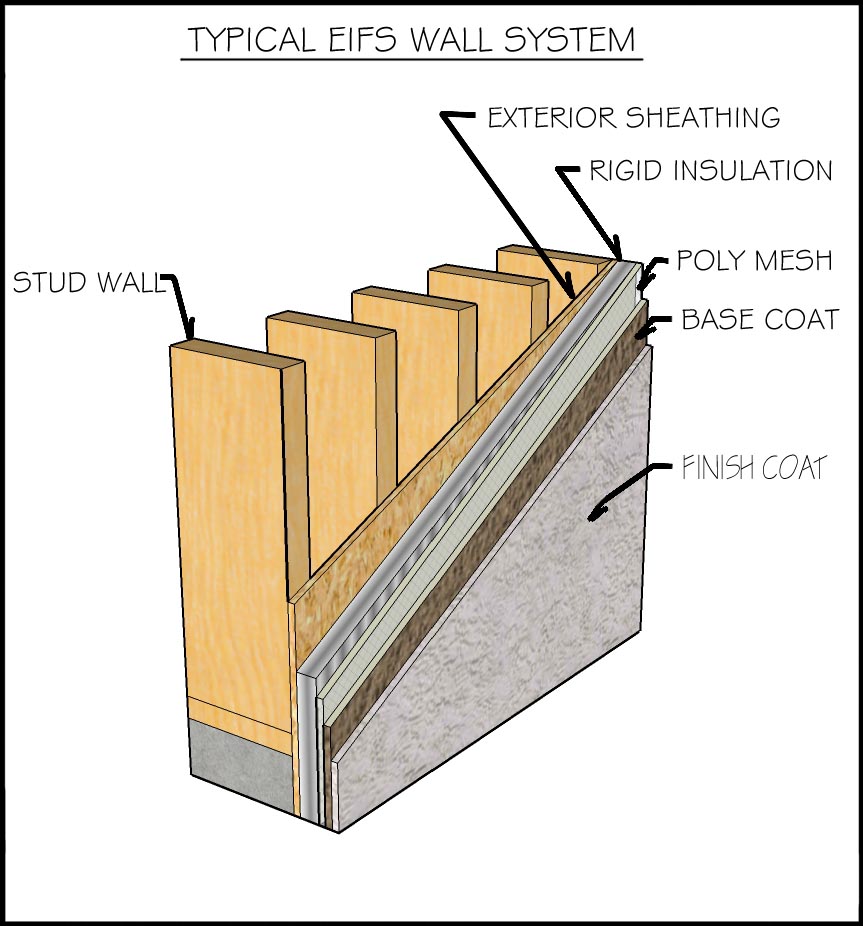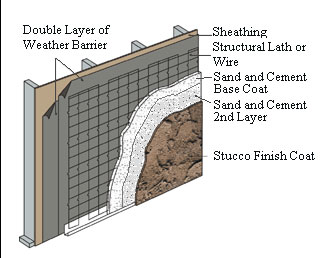

There are two main types of stucco with a 3rd product/process being called stucco by some major home builders that is not a cement plaster material at all and in some cases is just a textured polymer top coat over a cheap product we will discuss below.
The traditional hard coat stucco process that has been around for hundreds of years is a 2-3 coat cementitious stucco application that consists of a scratch coat, a brown coat and a finish coat, there are commercial products from large companies such as Dryvit, Sto and other that combine the finish coat with a weather resistant color/pigment included in the finish coat. These products generally are breathable with a perm rating that will allow some moisture behind the product but rapidly dry out by evaporation.
The manufactured stone products also known as lick in stick fall into the hard coat stucco, the stone is the final application and normally has gaps and crevices that will allow water past the artificial stone products that are becoming very popular and still require all the same flashing details for hard coat stucco under the building codes and ASTM standards
There are many commercial plaster products as well as homemade plaster created with cement, sand, lime, water, etc in various amounts that are often used, the issues with home made plasters is the lack of consistency in the mixes.
2. EIFS is a wall cladding that resembles stucco and it has an acrylic type of finish for its weatherability but is different than a hard coat stucco system when you look at the inner layers of the EIFS system.
EIFS uses multiple layers of products that makes a cladding system that attempts to use special specialized materials in an attempt to improve the water tightness of the wall system.
Some of the commercial products may use a WRB/air barrier, then an adhesive coat, foam insulative barrier, a base coat installed over a fiberglass mesh, a coat of primer (sometimes optional) and then a finish coat.
Parts Of Stucco Explained:
We will take a look at some of the parts of stucco and EIFS this may help you understand what they are, what they consist of and how they the two products differ.
(WRB) Water Resistive Barrier: WRB is one of the critical aspect of a weather tight structure, hard coat stucco requires 2 layers of a WRB but with EIFS they may not always a mandatory unless being installed as a “premium system” which gives the wall more water resistance.
Fluid Applied WRBs: These products are applied like a thick paint that is usually rolled on, brushed on or can be sprayed on to a minimum thickness as dictated by the product manufacturer. The coatings can not have any pin holes in the waterproofing and could allow water to come in and likely be trapped.
15 or 30 Pound Felt Paper: This is the same product often used for installing the roof on your home and has been around a very long time, both EIFS and Hard Coat Stucco may use these products for WRB.
The WRB will have fasteners such as nails, screws, etc. that attach the felt products to the wood substrate or stud framed walls for EIFS or Hard Coat Stucco.
Adhesive Coat or Mechanically Fastened: The foam is attached using an adhesive that is usually troweled on using a notched trowel and the notches will usually run vertically (up and down)Not all EIFS claddings call for an adhesive, sometimes the foam is mechanically fastened to the wall and an adhesive is not needed. This is not relevant for the Hard Coat Stuccos
The Foam Insulating Board: The foam board is used for the EIFS products and is one of the things that makes it different from Hard Coat Stucco. The foam board acts as an insulator for the structure can come in different thicknesses creating different R values based on the thickness, the thicker the foam, the more R Value you can get out of your walls.
The foam board is usually made from an eps type of foam and can have grooves on the back side that run vertically (up and down) to allow water to drain if it is ever present in the system.
The foam board can be attached mechanically, using staples, nails or screws or it can be attached using an adhesive, which is specifically designed to attach foam to other surfaces and acts as a very strong glue.
In some cases the foam board may have the seams taped with specialized tapes to be used to create a WRB out of the foam board, this was a common way on some of the earlier EIFS
Fiberglass Mesh And Base Coat: These are usually two different steps for an EIFS system but are often applied together and are essentially one single step because the base coat MUST be embedded into the mesh. The mesh is a fiberglass material that comes on a roll, similar to what you might use for drywall but is in larger widths up to 3′ wide.
Primer Coat: The primer coat is what it sounds like, a primer coat of paint goes on prior to the finish being applied. The primer coat may be optional but is almost always recommend seal the base coat which usually eliminates the possibilities of the base flaking off and affecting the finish coat. A prime coat is often required for the manufacturers warranty which in that case would make the primer a requirement.
Finish Coat: The finish coat is the final coat that goes on and is the coating you see on the outside of the building as the finished product. The finish is made up of acrylic materials and in some cases may be the same material that can be used on a Hard Coat Stucco wall system but could also be a different product so it important to readd the manufacturers specifications.
EIFS designed to be a water tight cladding that uses the finish coat layer to keep water out of the wall assembly, it is critical to have a near perfect installation to prevent leakage of the EIFS cladding.
Most manufacturers have specific finishes to be used for their EIFS system so its important to read the manufacturers installation instructions and specifications. Mixing and matching different manufacturers materials or even improper materials from the same manufacturer can result in failures.
Stucco Contract: The success of your Hard Coat starts with the ASTM mandated STUCCO CONTRACT,
Hard Coat Stucco Substrate: The cement plaster has to be installed over a rigid material such a wood substrate but may also be installed over an exterior gypsum board, Densglass or other rigid substrate. The wood substrate may be oriented strand board (OSB) or plywood.
Hard Coat Stucco WRB Materials: As stated above the WRB may be felt paper, but also may be other products but not limited to ZIP Board, Densglass, Fluid Applied, Tyvek (House Wraps), Peel n Stick, etc, the WRB and the flashing of the WRB are critical to the weatherability of your stucco to be moisture resistance.
The stucco cladding is the first line of defense to resist moisture but stucco plasters allow water behind the stucco, the WRB is what will make the structure water tight to leakage. Such things as elastomric paints DO NOT prevent leakage and often do way more harm by not allowing the home to breath and trapping moisture in the walls. These rubberized coatings should not be used in lieu of a proper stucco installation.
2nd Layer of WRB: A second layer of WRB is required for hard coat stucco’s, this second layer offers a line of defense and creates a bond break between the cement plaster and the 1st layer of WRB. The lack of the second layer of WRB due not allow for a bond break and often closes off the drainage plane created by the 1st layer of WRB installed above. The 2nd layer is often felt paper but can be other products such as a rain screen or second layer of house wrap.
Air Gap/Drainage Plane: Proper air gap is required and can be accomplished with a rain screen such the Keene Driwall LathNet as shown below, these products create the airgap and drainage plane as well they constitute the second layer of weather resistant barrier as well can be bought with the metal lath secured as seen in the photo.

The air space can also be accomplished by installing the stucco on furring strips that may be treated wood, plastic, felt pads, etc. These strips are installed vertically and create a drainage plane to allow moisture and air to travel up the or down the wall assembly and help prevent rot/leakage.

Hard Coat Stucco Flashings: Several key areas of flashing are required, not only do doors and windows have to be flashed by applicable building codes, AAMA Standards and ASTM Standards but the stucco itself is required to be flashed at each penetrations and termination. Such things such as penetrations (ie windows, doors, gable vents, etc) have to be head flashed with non corrosive flashing materials, other areas needing flashing details are the terminations such as the base of the stucco wall at the foundation, roof or intersection with brick/stone wainscoting requires flashings to terminate outside of the wall creating a drainage plane to help prevent leakage. Flashings may consist of weep screed’s, Z flashings, or even custom metal flashings as long as they comply with the code and ASTM, peal n stick flashings do not comply with the ASTM requirements and will only deal with water that enters behind the plaster.
Faux/Fake Stucco Materials
Fraudulent Materials: As listed in the beginning of this page we will discuss Faux/Fake Stucco, these products are not stucco at all and often are labeled as stucco by some builders and contractors in a fraudulent manor, when reading the definitions of stucco and plaster its not hard to see that these products do not fit in the category of stucco nor do they meet any building codes or ASTM standards required of stucco plasters. Some manufactures of the sheathing have changed their products and guidelines repeatedly and in some cases are now dropping their sheathing from the market place.
These FAKE STUCCO’S are applied over an OSB type of sheathing, a paper mulch sheathing applied to OSB type of material or over an exterior drywall/gypsum board relying on a waxy coating for its weather resistant barrier. A textured finish polymer top coat is applied over one of these sheathings to give the look of stucco but in-fact is no more than a wood or drywall sheathing creating issues for insurability and meeting the HOA’s requirements for masonry siding materials. These products are fraudulently applied in a fashion to trick the buyer, the HOA and the insurance company all believing they have a concrete plastered finish installed on their home..
These FAKE STUCCO’S have numerous issues and some companies such as Louisiana Pacific have dropped their Armor Strand products from the market for various reasons causing builder to install the gyp-board as the sheathing, the gyp-board itself not only creates issues wit as a WRB but also creates security issues that can allow someone to kick a hole through the exterior and interior wall of your home and easily gain access.
Additional issues with these products is the sheathings cannot touch masonry products to include fiber cement siding, stone, brick or even the foundation which they always do, they also are generally installed to short and do not overhang the foundation properly and allow water to leak directly under the the siding and into the home creating water damage and molds for the unsuspecting home owner that was specifically sold STUCCO.
